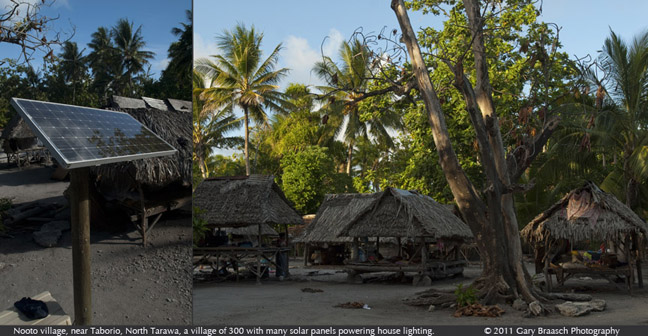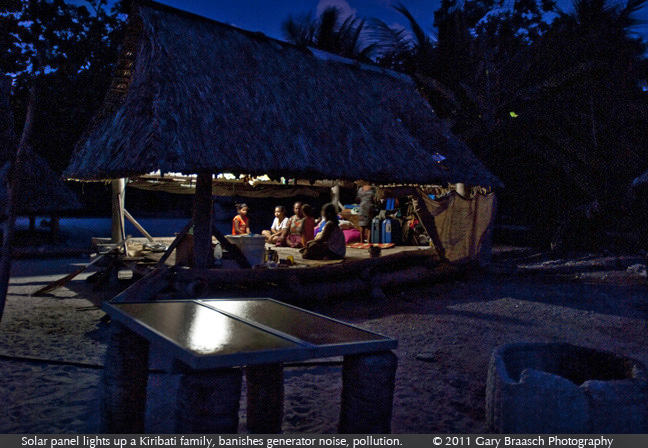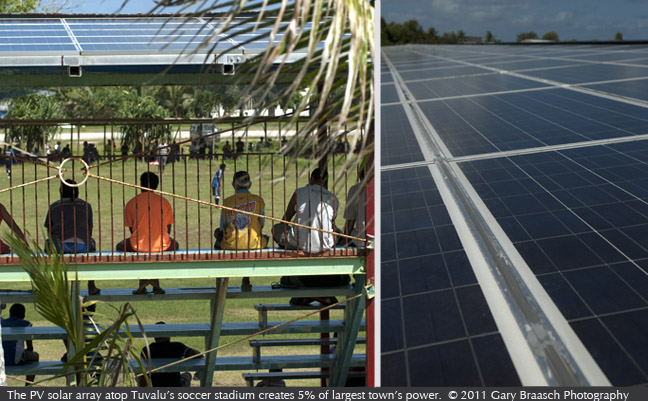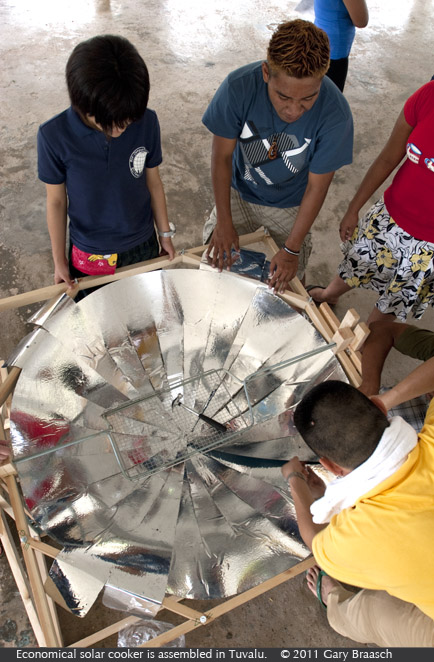Solar Power for Small Islands

Nations in the South Pacific which are under threat from climate change are also showing the way in small scale home solar energy -- creating more active, productive time in the evenings, cutting fuel costs and pollution, and reducing their already small carbon footprints. This is a family area in Nooto, a village of 300 on North Tarawa, Kiribati, with a meter-square photo-voltaic panel serving several houses. This island was the first in Kiribati to get home solar, beginning in the early 1990s in programs funded by Japan and the EU. Since then a government-sanctioned company, Kiribati Solar Electric Company, has managed the program. Now more than 2000 residential units and 100 community building solar systems have been installed on 18 islands.

The family of Bepano Tamara in Nooto village, North Tarawa, is enjoying increased nighttime use of their thatch-roofed home with the small solar panel set seen in the foreground. The panel charges a car battery during the day and the battery runs a single CFL bulb for most of the night, so the family and friends can read, study and weave mats. This eliminates the need for a generator and the cost of kerosene of up to $70 a month -- and its noise, odor and pollution. The Kiribati Solar Energy Company installs the PV panels, battery and wiring for about $80, after which the family pays $9 each month as a maintenance charge. Others in this village still use generators. One man said he chose not to get solar because it was easier for him to come up with the money to by kerosene when he needed it at about $2.50 a liter, than to pay the solar panel fee due on a certain day each month.
Update: Home installations of solar panels are also advancing rapidly in Bangladesh. Al-Jazzera reports that in two years more than a million homes have been equipped with panels which can power two bulbs for 10 hours.

In Tuvalu, stadium spectators at a soccer match sit beneath a solar PV array on the roof of the stands, which creates about five percent of the power for the town of Fongafale. The 40 kW grid-connected solar system was built in 2008 by the Japanese with assistance from a consortium of power companies from developed nations. Tuvalu is on a drive to replace diesel power generation by all renewable sources by 2020, and to greatly reduce other uses of fossil fuel. This is also important since high King tides now reach very close to the three diesel power generators on the main island, indicating a risk of power loss during storm or tsunami events. On Vaitupu, another island in Tuvalu, the national solar program was advanced by an installation at the Motufoua Secondary School which includes a battery bank allowing 24-hour access to electricity and which will save an estimated $80,000 in diesel fuel yearly.

Solar cooling is also gaining in the Pacific island nations. Traditionally cooking is done over a smoky open fire of coconut husks or palm fronds. Many families also use kerosene stoves, with pervasive unhealthy fumes and a monetary cost for the fuel. Here Professor Akira Sato and students from Ferris University in Japan are assembling an inexpensive solar dish cooker in Funafuti, Tuvalu. Sato has been working with the Secretariat of the Pacific Community (SOPAC) applied science division to test solar cookers in Tuvalu and Kiribati. In a report in 2008, Sato and colleagues said that using a solar stove could mean a "reduction of 9 litres of kerosene per month equivalent to about 22.401 kg of CO2. Food cooked included, rice, fish, breadfruit, pumpkin, shell fish and octopus."
For more on renewable energy in the Pacific Islands, please see this article.
COPYRIGHT NOTICE:
Photography and text Copyright © 2005 - 2017 (and before) Gary Braasch All rights reserved. Use of photographs in any manner without permission is prohibited by US copyright law. Photography is available for license to publications and other uses. Please contact requestinformation@worldviewofglobalwarming.org. View more of Gary Braasch's photography here.


